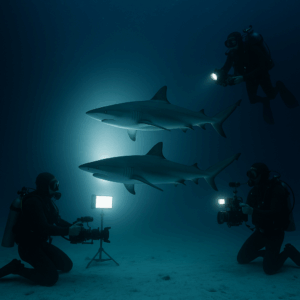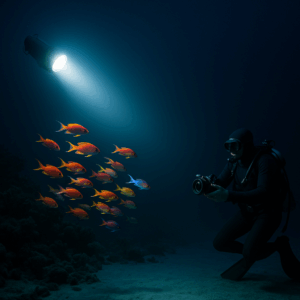I. Introduction
The world beneath the surface has always held a captivating allure. From shimmering coral reefs to the shadowy depths of the ocean, underwater environments provide filmmakers with an extraordinary canvas for storytelling. However, capturing these environments on film is no small feat. Beyond the technical challenges of waterproof housings, buoyancy control, and communication, one crucial element has consistently shaped the success of underwater shoots: lighting.
Proper lighting is fundamental to any film set, but underwater cinematography adds a host of new variables—refraction, color loss, movement, and visibility. For decades, cinematographers have battled these elements using lighting systems that were often inefficient, bulky, and unreliable. The emergence of LED technology has transformed this paradigm.
Today’s underwater LED lights deliver powerful, color-accurate, and energy-efficient illumination, opening new possibilities for filmmakers. In this industry spotlight, we explore the evolution of underwater LED lighting and its impact on modern film and television production.
II. A Brief History of Underwater Filming
Underwater cinematography dates back more than a century, with some of the earliest notable efforts appearing in the silent film era. Pioneering films like 20,000 Leagues Under the Sea (1916) attempted underwater scenes using innovative—if rudimentary—techniques, often involving shooting through aquariums or using water tanks.
As the technology matured, so did the ambition of filmmakers. Jacques Cousteau’s documentary The Silent World (1956) showcased groundbreaking underwater footage using custom-made waterproof housings and floodlights. However, the limitations of analog lighting systems were stark: tungsten and halogen lights generated excessive heat, drained power quickly, and required significant surface support infrastructure. These lighting units were also heavy and cumbersome, making them difficult to maneuver underwater.
Despite the introduction of higher-wattage fixtures in the 1970s and 80s, underwater lighting remained expensive and logistically complex. Visibility was often limited, and the available lights did not accurately replicate natural light, leading to footage that felt flat or discolored. Cinematographers frequently had to correct for the color blue overwhelming other hues, a task that was both creatively and technically draining.
III. The Emergence of LED Lighting
Light-emitting diode (LED) technology entered the cinematic scene in the late 1990s and early 2000s, initially as a niche solution for studio lighting. While early LEDs lacked the output needed for large-scale productions, they offered compelling benefits: cooler operation, longer lifespan, and greater energy efficiency. These advantages sparked interest in adapting LEDs for underwater use.
In the beginning, the transition was slow. Early underwater LEDs were limited in brightness and color accuracy, often falling short of the expectations set by traditional halogen setups. However, by the early 2010s, the technology had evolved significantly. Advancements in LED chip design, color mixing algorithms, and optics made it possible to produce high-output, color-accurate LED fixtures suitable for deep water use.
Manufacturers began producing sealed, pressure-resistant LED units with variable color temperature control and DMX compatibility. These fixtures were not only safer and lighter than their predecessors, but they also offered unprecedented control over underwater lighting environments—transforming the creative toolkit for directors and cinematographers.
IV. Key Technological Advancements in Underwater LED Lights
RGB+White Color Mixing
One of the most impactful developments has been the integration of RGB+White (or RGBWW) color systems. This technology enables precise color blending and adjustment across a full spectrum—from warm tungsten-like hues to cool daylight tones. Cinematographers can now simulate everything from moonlight filtering through waves to surreal bioluminescent glows.
High CRI/TLCI Ratings
Color Rendering Index (CRI) and Television Lighting Consistency Index (TLCI) scores measure how accurately a light source reveals colors compared to natural light. Modern underwater LEDs boast CRI and TLCI values over 95, ensuring that skin tones, fabrics, marine life, and props appear vivid and natural.
Pressure-Resistant Housing
Underwater LEDs now come encased in robust, corrosion-resistant housings that withstand depths up to 25 meters or more. These designs use hardened acrylic or borosilicate lenses and double O-ring seals to ensure water-tight performance even under significant pressure.
Wireless Control & DMX Integration
Controlling lights underwater was once a manual, cumbersome task. Today, many LED systems support DMX and wireless protocols, allowing real-time control from the surface. Operators can adjust brightness, hue, and effects without diver intervention, streamlining the workflow and enhancing safety.
Battery & Power Efficiency
Modern LED fixtures consume less power while delivering higher output. Advanced models run for hours on battery packs that are safe for underwater use. This efficiency reduces the need for external cabling and generators, simplifying logistics and expanding location possibilities.
Dimming and Flicker-Free Output
For high-speed or slow-motion filming, flicker-free performance is critical. LED technology now offers high-frequency dimming capabilities that eliminate flicker, even at frame rates of 120 fps and beyond—ideal for capturing underwater action sequences with stunning clarity.
V. Real-World Applications in Film and TV
Feature Films
Major productions have leveraged underwater LED technology to stunning effect. Avatar: The Way of Water set a new benchmark by combining motion capture with underwater performance and LED lighting. James Cameron’s team used LED panels in submerged volumes to simulate dynamic ocean lighting, resulting in hyper-realistic underwater visuals.
Similarly, Aquaman utilized sophisticated LED arrays to recreate oceanic lighting effects in controlled tank environments. These systems allowed the crew to adjust color temperature, create directional shafts of light, and simulate underwater haze in real time.
Documentaries
Nature documentaries like Blue Planet II rely on lightweight, battery-powered LED lights to document marine ecosystems. These lights are often mounted on diver rigs, submarines, or ROVs, allowing crews to explore previously unreachable locations while capturing vibrant, natural colors.

TV Productions
Streaming shows such as Outer Banks and The Witcher have also employed underwater LED setups for stunt work and water-based sequences. The portability and low heat output of LEDs make them ideal for fast-paced television production schedules.
VI. Benefits Over Traditional Underwater Lighting
Underwater LEDs have outperformed traditional halogen and HMI systems in nearly every regard:
VII. Challenges and Considerations
Despite their many benefits, underwater LEDs present specific engineering and operational challenges:
VIII. Future Trends and Innovations
The next wave of underwater LED innovation is already underway:

IX. Expert Insights
Underwater cinematographers emphasize reliability and versatility when selecting lighting gear.
“I need lights that I can trust 30 feet down—no leaks, no flicker, and total control,” says Helena Sorensen, an underwater DP with credits on both narrative features and wildlife series. “The latest LED systems give me that. I can change color, adjust angles, and even trigger effects from the surface.”
Lighting designer Rafael Kim adds, “RGBWW fixtures have been a game-changer. We used to spend hours gelling halogens to get the right look. Now it’s just a slider on the control panel.”
X. Conclusion
From early halogen rigs to cutting-edge RGB+White systems, the evolution of underwater LED lighting has profoundly impacted how filmmakers bring aquatic scenes to life. No longer confined by the limitations of older technologies, directors and cinematographers now wield a level of control, creativity, and safety once thought impossible.
As the film and TV industries push into new frontiers—from hybrid real-time virtual productions to ultra-realistic documentaries—underwater LED lighting stands at the forefront of visual innovation. With continued technological refinement, its role will only deepen—illuminating not just the ocean’s hidden depths, but the boundless potential of visual storytelling.
–The End–
Get in touch for free lighting customization